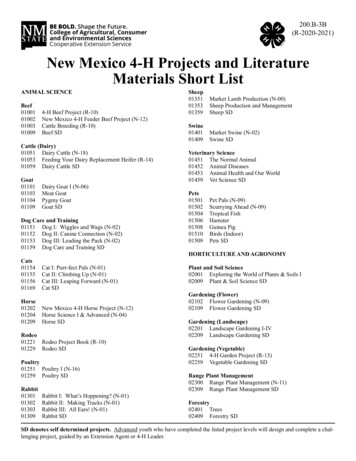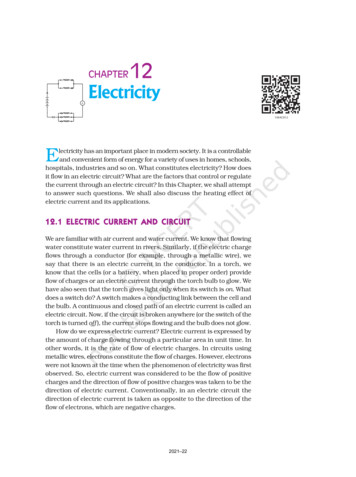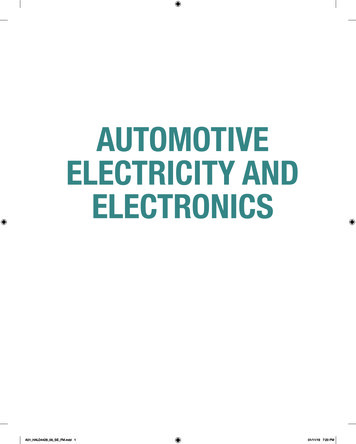
Transcription
AUTOMOTIVEELECTRICITY ANDELECTRONICSA01 HALD4428 06 SE FM.indd 101/11/19 7:20 PM
A01 HALD4428 06 SE FM.indd 201/11/19 7:20 PM
AUTOMOTIVEELECTRICITY ANDELECTRONICSS I X T HE D I T I O NJames D. HaldermanA01 HALD4428 06 SE FM.indd 301/11/19 7:20 PM
Director of Product Management: Linea RoweProduct Manager, Trades, Hospitality, & Careers: Derril TrakaloSenior Analyst, HE Global Content, Trades & Hospitality: Tara WarrensAnalyst, HE Global Content, Careers & Professional: Bridget DalyManager Content HE, Careers & Professional: Jenifer NilesDirector, Digital Studio & Content Production: Brian HylandManaging Content Producer: Jennifer SargunarManaging Producer, Teacher Education & Careers: Autumn BensonContent Producer (Team Lead): Faraz Sharique AliPermissions Editor: Jenell ForschlerCover Design: Carie Keller, SPiCover Credit: Courtesy of ASE; Henrik5000/E /Getty imagesFull-Service Management and Composition: Integra Software Service Pvt. Ltd.Printer/Binder: LSC Communications, Inc.Cover Printer: LSC Communications, Inc.Text Font: Helvetica Neue LT W1GCopyright 2021, 2017, 2014, by Pearson Education, Inc. 221 River Street, Hoboken, NJ 07030.All Rights Reserved. Printed in the United States of America. This publication is protected by copyright,and permission should be obtained from the publisher prior to any prohibited reproduction, storage in aretrieval system, or transmission in any form or by any means, electronic, mechanical, photocopying,recording, or otherwise. For information regarding permissions, request forms and the appropriatecontacts within the Pearson Education Global Rights & Permissions department, please visit www.pearsoned.com/permissions/.Unless otherwise indicated herein, any third-party trademarks, logos, or icons that may appear in thiswork are the property of their respective owners, and any references to third-party trademarks, logos,icons, or other trade dress are for demonstrative or descriptive purposes only. Such references are notintended to imply any sponsorship, endorsement, authorization, or promotion of Pearson’s products bythe owners of such marks, or any relationship between the owner and Pearson Education, Inc., authors,licensees, or distributors.Library of Congress Cataloging-in-Publication DataNames: Halderman, James D., author.Title: Automotive electricity and electronics / James D.Halderman.Description: Sixth edition. Hoboken, New Jersey : Pearson, 2020. Includes index.Identifiers: LCCN 2019033309 ISBN 9780135764428 (paperback) ISBN 9780135764626 (epub)Subjects: LCSH: Automobiles—Electric equipment. Automobiles—Electronicequipment. Automobiles—Electric equipment.—Maintenance and repair. Automobiles—Electronic equipment—Maintenance and repair.Classification: LCC TL272 .H22256 2020 DDC 629.25/4—dc23LC record available at CodeISBN-10:0-13-576442-4ISBN-13: 978-0-13-576442-8A01 HALD4428 06 SE FM.indd 401/11/19 7:20 PM
BRIEF CONTENTSchapter 1Service Information, Work Orders, and Vehicle Identificationchapter 2Tools and Safetychapter 3Environmental and Hazardous Materialschapter 4Electrical Fundamentalschapter 5Electrical Circuits and Ohm’s Lawchapter 6Series Circuitschapter 7Parallel Circuitschapter 8Series–Parallel Circuitschapter 9Circuit Testers and Digital Meterschapter 10Oscilloscopes and Graphing Multimeterschapter 11Automotive Wiring and Wire Repairchapter 12Wiring Schematics and Circuit Testingchapter 13Capacitance and Capacitorschapter 14Magnetism and Electromagnetismchapter 15Electronic Fundamentals171chapter 16Computer Fundamentals189chapter 17CAN and Network Communicationschapter 18Batterieschapter 19Battery Testing and Servicechapter 20Cranking Systemchapter 21Cranking System Diagnosis and Servicechapter 22Charging Systemchapter 23Charging System Diagnosis and Servicechapter 24Lighting and Signaling Circuitschapter 25Driver Information and Navigation Systemschapter 26Security and Anti-Theft Systems338chapter 27Airbag and Pretensioner 3238251266279301321vA01 HALD4428 06 SE FM.indd 501/11/19 7:20 PM
chapter 28Body Electrical Accessorieschapter 29Advanced Driver Assist Systems (ADAS)chapter 30Audio System Operation and Diagnosis362392404APPENDIX 1SAMPLE ELECTRICAL (A6) ASE-TYPE CERTIFICATION TESTWITH ANSWERS 419APPENDIX 22017 ASE CORRELATION CHART 423GLOSSARYINDEXvi426438BRIEF C ONTENTSA01 HALD4428 06 SE FM.indd 601/11/19 7:20 PM
CONTENTSchapter 1SERVICE INFORMATION,WORK ORDERS, AND VEHICLEIDENTIFICATION 1 Learning Objectives1Key Terms 1 Owner’s Manuals1 Service Information2 Technical Service Bulletins2 Recalls and Campaigns2 Work Order3 Service Records3 Additional Information5 Parts of a Vehicle5 Front-Wheel Drive Versus Rear-Wheel Drive Vehicle Identification5 Vehicle Safety Certification Label7 VECI Label7 Summary 7Review QuestionsChapter Quiz 88chapter 2TOOLS AND SAFETY Learning Objectives99Key Terms 9Threaded Fasteners 9 Hand Tools13 Screwdrivers16 Torx17 Pliers19 Basic Hand Tool List22 Tool Sets and Accessories23 Electrical Hand Tools23 Hand Tool Maintenance25 Trouble Lights25 Air and Electrically Operated Tools25 Personal Protective Equipment27 Safety Precautions28 Vehicle Protection29 Safety Lifting (Hoisting) a Vehicle29 Jacks and Safety Stands31 Drive-on Ramps31 Electrical Cord Safety32 Jump Starting and Battery Safety 32Fire Extinguishers 33 Fire Blankets34 First Aid and Eye Wash Stations34 Hybrid Electric Vehicle Safety Issues35 Summary 40Review Questions 40Chapter Quiz 40chapter 3ENVIRONMENTAL AND HAZARDOUSMATERIALS 42 Learning Objectives42Key Terms 42Hazardous Waste 42 Federal and State Laws42 Asbestos Hazards44 Used Brake Fluid45 Used Oil45 Solvents46 Coolant Disposal47 Lead-Acid Battery Waste48 Fuel Safety and Storage48 Airbag Handling49 Used Tire Disposal49 Air-Conditioning Refrigerant Oil Disposal 5 50Summary 52Review Questions 52Chapter Quiz 52chapter 4ELECTRICAL FUNDAMENTALS Learning Objectives5353Key Terms 53 Introduction53 Electricity53 How Electrons Move Through a Conductor Units of Electricity57 Sources of Electricity59 Conductors and Resistance60 Resistors61 56Summary 62Review Questions 62Chapter Quiz 63viiA01 HALD4428 06 SE FM.indd 701/11/19 7:20 PM
chapter 5ELECTRICAL CIRCUITS AND OHM’SLAW 64 Learning ObjectivesKey Terms 64Circuits 64 Circuit Fault Types Ohm’s Law67 Watt’s Law6964 65 SERIES CIRCUITS7272Key Terms 72 Series Circuits72 Ohm’s Law and Series Circuits Kirchhoff’s Voltage Law73 Voltage Drops74 Series Circuit Laws75 Series Circuit Examples7672chapter 10OSCILLOSCOPES AND GRAPHINGMULTIMETERS 111Summary77Review Questions77Chapter Quiz78 PARALLEL CIRCUITS7979Key Terms 79Parallel Circuits 79 Kirchhoff’s Current Law79 Parallel Circuit Laws80 Determining Total Resistance in a Parallel Circuit Parallel Circuit Calculation Examples83 80112Summary 118Review Questions 118Chapter Quiz 118Summary84Review Questions84Chapter Quiz85chapter 11chapter 8SERIES–PARALLEL CIRCUITS86Key Terms 86 Series–Parallel Circuits86 Solving Series–Parallel Circuit CalculationProblems 87 Series–Parallel Circuit Calculation Examples86AUTOMOTIVE WIRING AND WIREREPAIR 119 Learning Objectives119Key Terms 119 Automotive Wiring119 Ground Wires121 Battery Cables121 Jumper Cables122 viii111Key Terms 111 Types of Oscilloscopes111 Scope Setup and Adjustments AC Voltage113 DC and AC Coupling113 Pulse Trains114 Number of Channels114 Triggers114 Using a Scope115 Graphing Multimeter117 Graphing Scan Tools117 Learning ObjectivesLearning Objectives chapter 7 100Summary 110Review Questions110Chapter Quiz110 Learning Objectives93Key Terms 93 Fused Jumper Wire93 Test Lights94 Logic Probe95 Digital Multimeters95 Inductive Ammeters99 Diode Check, Duty Cycle, and Frequency Electrical Unit Prefixes101 How to Read Digital Meters102chapter 6 Learning Objectives Summary 70Review Questions 70Chapter Quiz 71Learning Objectiveschapter 9CIRCUIT TESTERS AND DIGITALMETERS 93 Summary89Review Questions89Chapter Quiz8987CONTENTSA01 HALD4428 06 SE FM.indd 801/11/19 7:20 PM
Fuses and Circuit Protection DevicesTerminals and Connectors 128 Wire Repair129 Electrical Conduit131 122Electromagnetic Induction 165Ignition Coils 166 Electromagnetic Interference168 Summary 169Review Questions169Chapter Quiz169Summary 132Review Questions 133Chapter Quiz 133chapter 15chapter 12WIRING SCHEMATICS AND CIRCUITTESTING 134 Learning Objectives134Key Terms 134Wiring Schematics and Symbols 134 Schematic Symbols135 Relay Terminal Identification140 Locating an Open Circuit143 Common Power or Ground144 Circuit Troubleshooting Procedure145 Locating a Short Circuit145 Electrical Trouble shooting Guide148 Step-by-Step Troubleshooting Procedure 149Summary 150Review Questions150Chapter Quiz150chapter 13CAPACITANCE ANDCAPACITORS 152Learning Objectives152Key Terms 152Capacitance 152 Capacitor Construction and Operation Factors of Capacitance155 Uses for Capacitors155 Capacitors in Circuits156 152Summary 157Review Questions157Chapter Quiz157 Summary 187Review Questions187Chapter Quiz187COMPUTER FUNDAMENTALSLearning Objectives189189Key Terms 189 Computer Fundamentals189 Computer Functions189 Digital Computers191 Computer Input Sensors193 Computer Outputs193 158Key Terms 158Fundamentals of Magnetism 158 Electromagnetism160 Uses of Electromagnetism162 171Key Terms 171 Semiconductors171 Summary of Semiconductors172 Diodes173 Zener Diodes174 High-Voltage Spike Protection174 Diode Ratings176 Light-Emitting Diodes176 Photodiodes177 Photoresistors177 Silicon-Controlled Rectifiers178 Thermistors178 Rectifier Bridges178 Transistors179 Field-Effect Transistors180 Phototransistors181 Integrated Circuits181 Transistor Gates182 Operational Amplifiers182 Electronic Component FailureCauses 183 How to Test Diodes and Transistors184 Converters and Inverters185 Electrostatic Discharge186 MAGNETISM ANDELECTROMAGNETISMLearning ObjectivesLearning Objectives171chapter 16chapter 14 ELECTRONICFUNDAMENTALS158Summary 195Review Questions 196Chapter Quiz 196C ON T EN T SA01 HALD4428 06 SE FM.indd 9ix01/11/19 7:20 PM
chapter 17CAN AND NETWORKCOMMUNICATIONS 197 Learning Objectives197Key Terms 197Module Communications and Networks 197 Network Fundamentals197 Module Communications Configuration199 Network Communications Classifications199 General Motors Communications Protocols200 Ford Network Communications Protocols203 Chrysler Communications Protocols203 Controller Area Network205 Honda/Toyota Communications206 European Bus Communications207 Network Communications Diagnosis208 OBD-II Data Link Connector211 Summary 212Review Questions 212Chapter Quiz 213chapter 18BATTERIES Learning Objectives214214Key Terms 214Introduction 214 Battery Construction214 How a Battery Works217 Specific Gravity217 Battery Construction Types218 Causes and Types of Battery Failure Battery Ratings220 Battery Sizes221219chapter 19BATTERY TESTING ANDSERVICE 223223Key Terms 223 Battery Service Safety Considerations223 Symptoms of a Weak or Defective battery223 Battery Maintenance224 Battery Voltage Test225 Hydrometer Testing226 Battery Load Testing226 Electronic Conductance Testing227 Battery Charging228xSummary 236Review Questions236Chapter Quiz236chapter 20CRANKING SYSTEM Learning Objectives238238Key Terms 238 Cranking Circuit238 Computer-Controlled Starting239 Starter Motor Operation240 How the Starter Motor Works242 Gear-Reduction Starters245 Starter Drives245 Starter Solenoids247 Stop-Start Systems248 CRANKING SYSTEM DIAGNOSISAND SERVICE 251Summary 221Review Questions222Chapter Quiz222Learning Objectives233chapter 21 Summary 249Review Questions249Chapter Quiz250 Battery Charge Time 230Float-Type Battery Chargers 230 Jump Starting231 Battery Electrical Drain Test231 Maintaining Electronic Memory Functions Battery Symptom Guide235 Learning Objectives251Key Terms 251 Starting System TroubleshootingProcedure 251 Voltage Drop Testing252 Control Circuit Testing254 Starter Amperage Test254 Starter Removal255 Starter Motor Service255 Bench Testing257 Starter Installation257 Starter Drive-to-Flywheel Clearance257 Starting System Symptom Guide259 Summary 264Review Questions264Chapter Quiz264chapter 22CHARGING SYSTEM Learning Objectives Key Terms266266266CONTEN TSA01 HALD4428 06 SE FM.indd 1001/11/19 7:20 PM
Principle of Alternator Operation 266Alternator Construction 266 Alternator Overrunning Pulleys267 Alternator Components and Operation How an Alternator Works271 Alternator Output Factors272 Alternator Voltage Regulation273 Alternator Cooling274 Computer-Controlled ChargingSystems 275LED Headlights 312Adaptive Front Lighting System 312 Automatic Headlights313 Headlight High/Low BeamSwitch 314 Auto Dimming Headlights314 Headlight Aiming314 Fog and Driving Lights314 Automatic Dimming Mirrors314 Courtesy Lights316 Illuminated Entry316 Headlight System Diagnosis317 Lighting System Diagnosis317 Lighting System SymptomGuide 318 269Summary 277Review Questions277Chapter Quiz277chapter 23CHARGING SYSTEM DIAGNOSISAND SERVICE 279 Learning Objectives279Key Terms 279 Charging System Testing and Service Drive Belt Inspection andAdjustment 281 AC Ripple Voltage Check282 Testing AC Ripple Current284 Charging System Voltage DropTesting 285 Alternator Output Test286 Minimum Required AlternatorOutput 286 Alternator Removal287 Alternator Disassembly288 Testing the Rectifier290 Reassembling the Alternator290 Remanufactured Alternators291 Alternator Installation291chapter 25 279321Key Terms 321Dash Warning Symbols 321 Steering Wheel Controls322 Voice Activation322 Maintenance Indicators323 Analog and Digital Displays323 Head-up Display324 Night Vision325 Electronic Displays326 Virtual Display327 Touch Screens327 Speedometers/Odometers328 Dash Gauges330 Navigation and GPS331 Telematics333 Backup Camera335 LIGHTING AND SIGNALINGCIRCUITS 301301Key Terms 301Lighting Systems 301 LED Lighting302 Bulb Numbers304 Brake Lights305 Turn Signals305 Daytime Running Lights308 Headlights308 High-Intensity Discharge HeadlightsLearning Objectives chapter 24Learning ObjectivesDRIVER INFORMATION ANDNAVIGATION SYSTEMS 321 Summary 299Review Questions 299Chapter Quiz 299 Summary 320Review Questions 320Chapter Quiz 320Summary 336Review Questions 336Chapter Quiz 336chapter 26SECURITY AND ANTI-THEFTSYSTEMS 338 Learning Objectives338Key Terms 338 Vehicle Security Systems338 Immobilizer Systems339 Chrysler Immobilizer System341 309C ON T EN T SA01 HALD4428 06 SE FM.indd 11xi01/11/19 7:20 PM
Ford PATS System 341General Motors Antitheft System 342 Testing Immobilizer Systems343Adjustable Pedals 385Folding Outside Mirrors 386 Keyless Entry386 Garage Door Opener388 Remote Start389 Summary 345Review Questions 345Chapter Quiz 345Summary 390Review Questions 390Chapter Quiz 390chapter 27AIRBAG AND PRETENSIONERCIRCUITS 347 Learning Objectives347Key Terms 347Safety Belts and Retractors 347 Front Airbags349 Airbag Diagnosis Tools and Equipment353 Airbag System Service355 Driver Side Airbag Module Replacement356 Safety When Manually Deploying Airbags356 Occupant Detection Systems357 Seat and Side Curtain Airbags359 Event Data Recorders359 Summary 360Review Questions360Chapter Quiz360chapter 28BODY ELECTRICALACCESSORIES 362 Learning Objectives362Key Terms362 Horns362 Horn Diagnosis363 Windshield Wipers364 Windshield Washers366 Rain-Sense Wipers369 Blower Motor370 Cruise Control372 Heated Rear WindowDefoggers 373 Power Windows375 Electric Power Door Locks377 Trunk/Lift Gate Locks380 Power Sun Roof/Moon Roof380 Sun Shades380 Power Seats381 Electrically Heated Seats383 Heated and Cooled Seats383 Heated Steering Wheel384 Heated Mirrors385 xiiChapter 29ADVANCED DRIVER ASSISTSYSTEMS (ADAS) 392 Learning Objectives392Key Terms 392Advanced Driver Assist Systems 392 Blind Spot Monitor393 Parking-Assist Systems394 Lane Departure Warning395 Lane Keep Assist395 Adaptive Cruise Control396 Rear Cross-Traffic Warning (RCTW)398 Automatic Emergency Braking398 Pre-Collision System399 Hill Start Assist399 ADAS Diagnosis400 Camera and Radar Sensor Calibration400 Summary 402Review Questions 403Chapter Quiz 403chapter 30AUDIO SYSTEM OPERATIONAND DIAGNOSIS 404 Learning Objectives404Key Terms 404Audio Fundamentals 404 Radios and Receivers406 Antennas406 Antenna Diagnosis407 Speakers408 Speaker Types410 Sound Levels410 Crossovers411 Aftermarket Sound SystemUpgrade 411 Voice Recognition413 Bluetooth413 Satellite Radio414 Radio Interference415 CONTENTSA01 HALD4428 06 SE FM.indd 1201/11/19 7:20 PM
Summary 418Review Questions418Chapter Quiz418appendix 22017 ASE Correlation Chartappendix 1Sample Electrical (A6) ASE-Type Certification Test withAnswers 419GLOSSARYINDEX423426438C ON T EN T SA01 HALD4428 06 SE FM.indd 13xiii01/11/19 7:20 PM
A01 HALD4428 06 SE FM.indd 1401/11/19 7:20 PM
PREFACENEW TO THIS EDITION. Based on the suggestions andrecommendations from automotive instructors and reviewers,the following changes have been made to the sixth edition:1. The number of chapters has been increased from 28 to 30making it easier to select the exact content to study or teach.2. The content in each chapter has been updated and expanded with over 40 new full color photos and line drawings to make the subject come alive.3. The beginning chapters are more concisely organizedmaking learning electrical systems easier. For example,the first chapter has been expanded and then divided intotwo shorter chapters: Chapter 1—Service Information, Work Orders, andVehicle IdentificationChapter 2—Tools and Safety4. All of the electrical accessory circuits have been expandedso that it meets all of the latest ASE tasks and then dividedinto three chapters including: Chapter 26—Security and Anti-Theft SystemsChapter 28—Body Electrical AccessoriesChapter 29—Advanced Driver Assist Systems5. New Case Studies included in this edition covering the“three Cs” (Complaint, Cause, and Correction).6. New OSHA hazardous chemical labeling requirementsadded to Chapter 3 (Environmental and HazardousMaterials).7. Static electricity and lightning information added toChapter 4 (Electrical Fundamentals)8. New content on three-legged and low-profile fuses, plussmart junction boxes, added to Chapter 11 (AutomotiveWiring and Wire Repair).9. Enhanced lead–acid batteries (ELA) information added toChapter 18 (Batteries).10. New content on float-type battery charges and memorysaver tool that uses a 12-volt battery to connect to thepower (terminal 16) and ground (terminals 4 and 5) of theDLC added to chapter 19 (Battery Testing and Service).11. Stop-start and push-button start system added toChapter 20 (Cranking Systems).12. Cloudy headlight restoration information added to Chapter24 (Lighting and Signaling Circuits).13. Dash warning symbols (122 of them) added to Chapter 25(Driver Information and Navigation Systems).14. Airbag inflator sequences of inflation added to Chapter 27(Airbags and Pretensioners).ASE CORRELATED ASE-certified programs need to demonstrate that they use course material that covers ASE tasks. AllProfessional Technician textbooks have been correlated to theappropriate ASE task lists.A COMPLETE INSTRUCTOR AND STUDENT SUPPLE MENTS PACKAGE All Professional Technician textbooksare accompanied by a full set of instructor and student supplements. Please see page xvi for a detailed list of supplements.A FOCUS ON DIAGNOSIS AND PROBLEM SOLVINGThe Professional Technician Series has been developed tosatisfy the need for a greater emphasis on problem diagnosis. Automotive instructors and service managers agree thatstudents and beginning technicians need more training in diagnostic procedures and skill development. To meet this needand demonstrate how real-world problems are solved, the CaseStudy features are included throughout and highlight how reallife problems are diagnosed and repaired.The following pages highlight the unique core features thatset the Professional Technician Series book apart from otherautomotive textbooks.xvA01 HALD4428 06 SE FM.indd 1501/11/19 7:20 PM
IN-TEXT FEATURESchapter1Safety T ipSERVICE INFORMATION,WORK ORDERS, ANDVEHICLE IDENTIFICATIONShop Cloth DisposalLEARNING OBJECTIVES:After studying this chapter, the reader should be able to:Discuss the importance of vehicle owner’s manuals, servicerecords, and service information.Explain the different types of service information.Describe vehicle recalls and campaigns.Discuss the importance of the work order.Explain why service records are important.Discuss the parts of a vehicle, and differentiate betweenfront-wheel drive and rear-wheel drive.Explain vehicle identification, vehicle safety certification label,and the VECI label.Discuss the different types of emission standards.Explain calibration codes and casting numbers.This chapter will help prepare for the Suspension and Steering(A4) and Brakes (A5) ASE certification test.KEY TERMS: Campaign 2 Country of origin 6 Flat rate 3 Gross axle weight rating (GAWR) 7 Gross vehicle weight rating(GVWR) 7 Model year (MY) 6 Owner’s manual 1 Recall 2 Repair order (RO) 3 Service information 2 Technicalservice bulletin (TSB) 2 Vehicle emissions control information (VECI) 7 Vehicle identification number (VIN) 6 Work order 3OWNER’S MANUALSAlways dispose of oily shop cloths in an enclosedcontainer to prevent a fire. SEE FIGURE 1–69.Whenever oily cloths are thrown together on the flooror workbench, a chemical reaction can occur, whichcan ignite the cloth even without an open flame. Thisprocess of ignition without an open flame is calledspontaneous combustion.CONTENTThe owner’s manual is the instructional bookletthat comes with every new vehicle and includes important information. It has been said by many automotive professionaltechnicians and service advisors that the owner’s manual is notread by many vehicle owners. Most owners’ manuals contain allor most of the following information.SAFETY TIPS alert students to possible hazards on the joband how to avoid them.1. Meaning of dash symbols2. How to reset the maintenance reminder light3. Specifications, including viscosity of oil needed and number of quarts (liters)4. Tire pressures and standard, as well as optional, tire sizes5. Maintenance schedule for all fluids, including coolant, brakefluid, automatic transmission fluid, and differential fluid6. How to program the remote control, as well as the powerwindows and door locks7. How to reset the tire pressure monitoring system (TPMS)after a tire rotation. SEE FIGURE 1–1.FIGURE 1–1 The owner’s manual has a lot of informationpertaining to the operation, as well as the maintenance andresetting procedures, that technicians often need.S E R V IC E IN F O R M A T IO N , W O R K O R D E R S , A N D V E H IC L E ID E N T IF ICA TION1LEARNING OBJECTIVES AND KEY TERMSappear atthe beginning of each chapter to help students and instructorsfocus on the most important material in each chapter. Thechapter objectives are based on specific ASE and NATEF tasks.TECH TIPIt Just Takes a SecondWhenever removing any automotive component, it iswise to screw the bolts back into the holes a coupleof threads by hand. This ensures that the right boltwill be used in its original location when the component or part is put back on the vehicle.TECH TIPSfeature real world advice and “tricks of thetrade” from ASE-certified master technicians.xviCASE STUDYLightning DamageA radio failed to work in a vehicle that was outsideduring a thunderstorm. The technician checked thefuses and verified that power was reaching the radio.Both the radio and the a ntenna were replaced to correct the problem. SEE FIGURE 28–26.Summary: Complaint—Customer stated that the radio didnot work. Cause—Visual inspection showed an antenna thathad been stuck by lightning. Correction—Replacing the radio and the antennarestored proper operation.CASE STUDYpresent students with actual automotivescenarios and show how these common (and sometimesuncommon) problems were diagnosed and repaired.IN- TE XT FEA TUR ESA01 HALD4428 06 SE FM.indd 1601/11/19 7:20 PM
?FREQUENTLY ASKED QUESTIONHOISTING THE VEHICLEHow Many Types of Screw Heads Are Used inAutomotive Applications?1There are many, including Torx, hex (also calledAllen), plus many others used in custom vans andmotor homes. SEE FIGURE 1–9.3FREQUENTLY ASKED QUESTIONS are based on theauthor’s own experience and provide answers to many of themost common questions asked by students and beginningservice technicians.Note: Claw hammer has a claw used to remove nails;therefore, it is not for automotive service.NOTESprovide students with additional technical informa tion to give them a greater understanding of a specific task orprocedure.CAUTION: Do not use a screwdriver as a pry toolor chisel. Screwdrivers use hardened steel only atthe tip and are not designed to be pounded on orused for prying because they could bend easily.Always use the proper tool for each application.CAUTIONS alert students about potential damage tothe vehicle that can occur during a specific task or serviceprocedure.WARNINGDo not use incandescent trouble lights around gasoline or other flammable liquids. The liquids can causethe bulb to break and the hot filament can ignite theflammable liquid, which can cause personal injury oreven death.WARNINGSalert students about potential dangers tothemselves during a specific task or service procedure.538The first step in hoisting a vehicle is to properly alignthe vehicle in the center of the stall.The arms can be moved in and out and most padscan be rotated to allow for many different types ofvehicle construction.Tall pad extensions can also be used to gain accessto the frame of a vehicle. This position is needed tosafely hoist many pickup trucks, vans, and sport utility vehicles.STEP BY STEP246Most vehicles will be correctly positioned when theleft front tire is centered on the tire pad.Most lifts are equipped with short pad extensionsthat are often necessary to use to allow the pad tocontact the frame of a vehicle without causing thearm of the lift to hit and damage parts of the body.An additional extension may be necessary to hoist atruck or van equipped with running boards to give thenecessary clearance.79Position the pads under the vehicle under therecommended locations.With the vehicle raised 1 foot (30 cm) off the ground,push down on the vehicle to check to see if it is stableon the pads. If the vehicle rocks, lower the vehicleand reset the pads. The vehicle can be raised to anydesired working level. Be sure the safety is engagedbefore working on or under the vehicle.11C H A P TER 2When the service work is completed, thehoist should be raised slightly and the safetyreleased before using the hydraulic lever tolower the vehicle.8After being sure all pads are correctly positioned,use the electromechanical controls to raise thevehicle.1012If raising a vehicle without a frame, place theflat pads under the pinch weld seam to spreadthe load. If additional clearance is necessary,the pads can be raised as shown.After lowering the vehicle, be sure all armsof the lift are moved out of the way beforedriving the vehicle out of the work stall.T OOLS A ND S A F ET Y39STEP-BY-STEP photo sequences show in detail the stepsinvolved in performing a specific task or service procedure.SUMMARY1. Bolts, studs, and nuts are commonly used as fastenersin the chassis. The sizes for fractional and metric threadsare different and are not interchangeable. The grade is therating of the strength of a fastener.2. Whenever a vehicle is raised above the ground, it mustbe supported at a substantial section of the body orframe.3. Wrenches are available in open end, box end, and combination open and box end.7. Torque wrenches measure the amount of torque appliedto a fastener.8. Screwdriver types include straight blade (flat tip) andPhillips.9. Hammers and mallets come in a variety of sizes andweights.10. Pliers are a useful tool and are available in many differenttypes, including slip-joint, multigroove, linesman’s, diagonal, needle-nose, and locking pliers.4. An adjustable wrench should only be used where theproper size is not available.11. Other common hand tools include snap-ring pliers, files,cutters, punches, chisels, and hacksaws.5. Line wrenches are also called flare-nut wrenches, fittingwrenches, or tube-nut wrenches and are used to removefuel or refrigerant lines.12. Hybrid electric vehicles should be de-powered if any ofthe high-voltage components are going to be serviced.6. Sockets are rotated by a ratchet or breaker bar, alsocalled a flex handle.REVIEW QUESTIONS1. Why are wrenches offset 15 degrees?2. What are the other names for a line wrench?4. Which type of screwdriver requires the use of a hammeror mallet?3. What are the standard automotive drive sizes for sockets?5. What is inside a dead-blow hammer?CHAPTER QUIZ1. The correct location for the pads when hoisting or jackingthe vehicle can often be found in the .a. service manualc. owner’s manualb. shop manuald. all of the above5. Wrenches are made from .a. cast from nickel steelb. forged alloy steelc. machined from billet steeld. cast from chrome steel2. For the best working position, the work should be.a. at neck or head levelb. at knee or ankle levelc. overhead by about 1 footd. at c
automotive electricity and electronics sixth edition james d





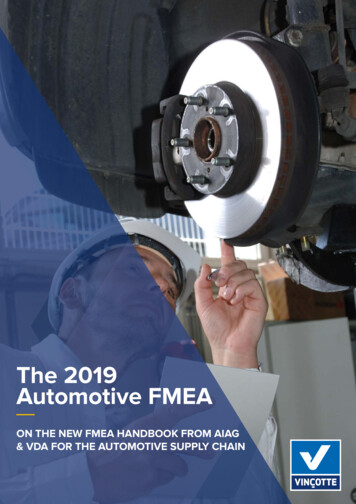
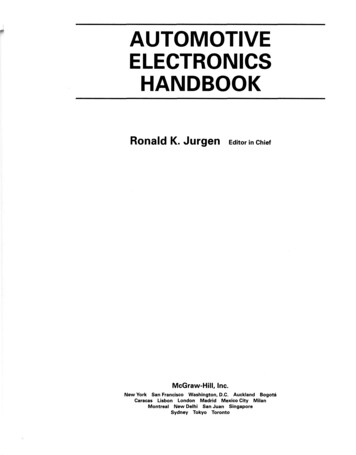
![History of Electronics electricity [Read-Only]](/img/18/history-20of-20electronics-20-20electricity.jpg)

